History
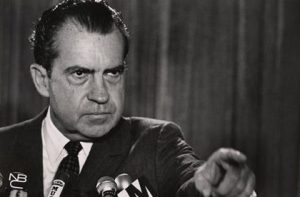 On December 13, 1972, peace talks with North Vietnam broke down, and President Richard Nixon announced that the United States will begin a massive bombing campaign to break the stalemate. Nixon was furious, and order the plans drawn up for retaliatory bombings of North Vietnam, and Linebacker II was the result. The bombings began on December 18, 1972 and continued until December 29, 1972. Beginning with American B-52s and fighter-bombers dropping over 20,000 tons of bombs on the cities of Hanoi and Haiphong. The United States lost 15 of its giant B-52s and 11 other aircraft during the attacks. North Vietnam claimed that over 1,600 civilians were killed. After eleven days of the massive pounding, the North Vietnamese agreed to resume the talks.
On December 13, 1972, peace talks with North Vietnam broke down, and President Richard Nixon announced that the United States will begin a massive bombing campaign to break the stalemate. Nixon was furious, and order the plans drawn up for retaliatory bombings of North Vietnam, and Linebacker II was the result. The bombings began on December 18, 1972 and continued until December 29, 1972. Beginning with American B-52s and fighter-bombers dropping over 20,000 tons of bombs on the cities of Hanoi and Haiphong. The United States lost 15 of its giant B-52s and 11 other aircraft during the attacks. North Vietnam claimed that over 1,600 civilians were killed. After eleven days of the massive pounding, the North Vietnamese agreed to resume the talks.
A few weeks later, the treaty was finally signed and the Vietnam War ended. This also ended the United States’ role in a conflict that seriously damaged the domestic Cold War consensus among the American public. The 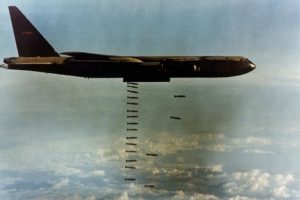 impact of the so-called “Christmas Bombings” on the final agreement remains a question. Some historians have argued that the bombings forced the North Vietnamese back to the negotiating table. Others thought that the attacks had little impact, other than the additional death and destruction they caused. Even the chief United States negotiator, Henry Kissinger, was reported to have said, “We bombed the North Vietnamese into accepting our concessions.” The chief impact may have been in convincing America’s South Vietnamese allies, who were highly suspicious of the draft treaty worked out in October 1972, that the United States would not desert them. Despite the forced return to the table, the final treaty did not include any important changes from the October draft.
impact of the so-called “Christmas Bombings” on the final agreement remains a question. Some historians have argued that the bombings forced the North Vietnamese back to the negotiating table. Others thought that the attacks had little impact, other than the additional death and destruction they caused. Even the chief United States negotiator, Henry Kissinger, was reported to have said, “We bombed the North Vietnamese into accepting our concessions.” The chief impact may have been in convincing America’s South Vietnamese allies, who were highly suspicious of the draft treaty worked out in October 1972, that the United States would not desert them. Despite the forced return to the table, the final treaty did not include any important changes from the October draft.
I believe that the bombings were instrumental in bringing the North Vietnamese back to the table, but I sometimes wonder what the emotional impact was on the men involved in the bombings. It’s hard to wage war  at anytime, but when you think of the Christmas season, and all it stands for, I must have been terribly hard to drop those bombs and end the lives of so many on what should have been a joyous holiday. I’m sure the men thought of their own families and children too. Of course, I don’t know what the North Vietnamese did about Christmas, or if it was anything to them at all, but it was to our men, and it seems to me that it would be very hard to take lives on that day…especially when, in times past it seems like it was common practice to have a cease fire on that day, but then I guess that can’t always be the case. Someone somewhere would insist on breaking the day of peace, because that is what war is all about, after all.
at anytime, but when you think of the Christmas season, and all it stands for, I must have been terribly hard to drop those bombs and end the lives of so many on what should have been a joyous holiday. I’m sure the men thought of their own families and children too. Of course, I don’t know what the North Vietnamese did about Christmas, or if it was anything to them at all, but it was to our men, and it seems to me that it would be very hard to take lives on that day…especially when, in times past it seems like it was common practice to have a cease fire on that day, but then I guess that can’t always be the case. Someone somewhere would insist on breaking the day of peace, because that is what war is all about, after all.
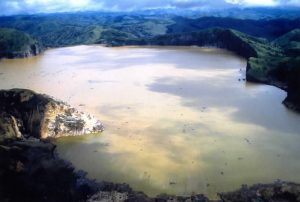 We have all heard about volcanic eruptions, seen photos or video of one, or maybe even seen one in person. They are an event that makes it hard to take your eyes off of the scene. There are volcanos that erupt often, and there are those that haven’t erupted in hundreds of years. And, there are volcanos that erupt under the ocean. But…there is a rare type of eruption, that is, in fact so rare that it has only been observed twice, although it may have happened elsewhere. It is called a Limnic Eruption.
We have all heard about volcanic eruptions, seen photos or video of one, or maybe even seen one in person. They are an event that makes it hard to take your eyes off of the scene. There are volcanos that erupt often, and there are those that haven’t erupted in hundreds of years. And, there are volcanos that erupt under the ocean. But…there is a rare type of eruption, that is, in fact so rare that it has only been observed twice, although it may have happened elsewhere. It is called a Limnic Eruption.
A limnic eruption, also called a lake overturn, is a rare type of natural disaster in which dissolved carbon dioxide (CO2) gas suddenly erupts from deep lake waters. The eruption forms a gas cloud that can suffocate wildlife, livestock, and humans. It can also cause tsunamis in the lake as the rising CO2 displaces the water. Scientists believe earthquakes, volcanic activity, or explosions can be a trigger for such an explosion. Lakes in which limnic activity occurs are known as limnically active lakes or exploding lakes. Some clues as to limnically active lakes include: CO2 saturated incoming water, a cool lake bottom indicating an absence of direct volcanic interaction with lake waters, an upper and lower thermal layer with differing CO2 saturations, and proximity to areas with volcanic activity, all of which are possible indicators of a limnic lake.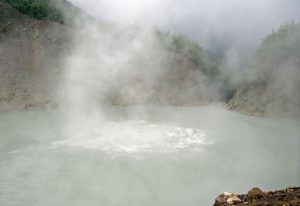
After a Limnic explosion the water left in the lake is filled with debris and massive amounts of dissolved CO2. To date, this phenomenon has been observed only twice. The first was in Cameroon at Lake Monoun in 1984, causing the asphyxiation and death of 38 people living nearby. A second, deadlier eruption happened at neighboring Lake Nyos in 1986, this time releasing over 80 million cubic meters of CO2 and killing around 1,700 people and 3,500 livestock, again by asphyxiation. When the explosion occurred in Lake Nyos, a geyser of water shot out of the lake reaching a height of 300 feet. A small tsunami rushed over the land, followed by a carbon dioxide blast that asphyxiated people up to 15 miles away. Scientists believe limnic explosions are caused by pockets of magma under lakes, which leak and cause carbonic acid to form. In an effort to prevent future explosions, degassing tubes were installed in Lake Nyos to allow the gas to leak at a safe rates.
A third lake, Lake Kivu, on the border between the Democratic Republic of the Congo and Rwanda, also contains massive amounts of dissolved CO2, and it is believed that Limnic eruptions have occurred there too.  Sample sediments from the lake were taken by professor Robert Hecky from the University of Michigan, which showed that an event caused living creatures in the lake to go extinct approximately every thousand years, and caused nearby vegetation to be swept back into the lake. Limnic eruptions can be measured on a scale using the concentration of CO2 in the surrounding area. Due to the nature of the event, it is hard to determine if limnic eruptions have happened elsewhere. The Messel pit fossil deposits of Messel, Germany, also show evidence of a limnic eruption there. Among the victims of that eruption are perfectly preserved insects, frogs, turtles, crocodiles, birds, anteaters, insectivores, early primates and paleotheres.
Sample sediments from the lake were taken by professor Robert Hecky from the University of Michigan, which showed that an event caused living creatures in the lake to go extinct approximately every thousand years, and caused nearby vegetation to be swept back into the lake. Limnic eruptions can be measured on a scale using the concentration of CO2 in the surrounding area. Due to the nature of the event, it is hard to determine if limnic eruptions have happened elsewhere. The Messel pit fossil deposits of Messel, Germany, also show evidence of a limnic eruption there. Among the victims of that eruption are perfectly preserved insects, frogs, turtles, crocodiles, birds, anteaters, insectivores, early primates and paleotheres.
 Many years ago, anyone suffering from a communicable disease in Superior, Wisconsin, who wanted to save other family members from becoming ill could be treated at the Isolation Hospital. Superior’s twenty six room Isolation Hospital was located at 2222 East 10th Street, in Superior, Wisconsin. The hospital treated such diseases as smallpox, scarlet fever, diphtheria, and meningitis. Each of the diseases were treated in separate wards of the building, in an effort to isolate on illness from another. The hospital was managed by Mr and Mrs Peter Roe. The hospital always had a registered nurse on duty and patients could hire a private nurse as well, if needed. Mrs Roe cooked all the meals for the patients under the direction of their attending physicians. To help the patients pass the time while they were confined, “The Evening Telegram” and Superior citizens raised money for a radio. The hospital was under the supervision of Dr George Conklin. Because it was harder to cure diseases in days gone by, people might find themselves confined for some time, even the rest of their lives.
Many years ago, anyone suffering from a communicable disease in Superior, Wisconsin, who wanted to save other family members from becoming ill could be treated at the Isolation Hospital. Superior’s twenty six room Isolation Hospital was located at 2222 East 10th Street, in Superior, Wisconsin. The hospital treated such diseases as smallpox, scarlet fever, diphtheria, and meningitis. Each of the diseases were treated in separate wards of the building, in an effort to isolate on illness from another. The hospital was managed by Mr and Mrs Peter Roe. The hospital always had a registered nurse on duty and patients could hire a private nurse as well, if needed. Mrs Roe cooked all the meals for the patients under the direction of their attending physicians. To help the patients pass the time while they were confined, “The Evening Telegram” and Superior citizens raised money for a radio. The hospital was under the supervision of Dr George Conklin. Because it was harder to cure diseases in days gone by, people might find themselves confined for some time, even the rest of their lives.
Smallpox was probably the most widespread medical terror in our past. Smallpox outbreaks occurred in 1894 and 1872, and the state was swept by cholera in 1849. The same disease had decimated the troops at Fort Crawford in August 1833, taking down 23 soldiers and killing six. But the most notorious epidemic in our history was surely the Lake Superior smallpox outbreak of 1770, when the British deliberately introduced the disease among the Ojibwa Indians in revenge for the death of a fur trader. At least 300 people around modern Duluth-Superior were killed in this early act of bioterrorism. In August of 1895, smallpox had swept through the south side of Milwaukee where the traditions of recent Polish immigrants clashed with modern public health practices. The first patients were segregated at the Isolation Hospital outside the neighborhood, even though the residents preferred caring for their own sick in their own homes, as they had in the old country. When hospital patients began dying, the residents came to see it as a slaughterhouse where they would never send their loved ones. This only increased the spread of disease, of course, and soon thousands were affected. But when city health officials or ambulances attempted to remove patients to protect the uninfected, they were met by barricaded doors and armed uprisings.
Eventually Saint Mary’s Hospital replaced the Isolation Hospital. The new hospital was finished in 1911, but it 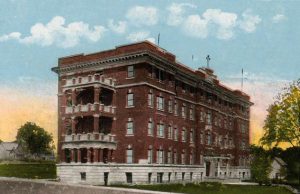 was the smallpox outbreak of May, 1915 that really put it to the test. The outbreak in Madison filled the hospitals and even took down the staff at Saint Mary’s, including the nurses and nuns. Smallpox was a terrible disease, for which there was no immunization in early years. Now with much hard work, and scientific research, it is considered a disease of the past. It also bears mentioning, that today, every time there is an outbreak of a contagious disease, doctors, nurses, staff, as well as friends and family wear protective gowns, gloves, and masks, in an effort to stop the spread of the disease. Medicine has come a long way since the days of the 1894 Smallpox epidemics. There are many ways to help people fight and win their battle against disease.
was the smallpox outbreak of May, 1915 that really put it to the test. The outbreak in Madison filled the hospitals and even took down the staff at Saint Mary’s, including the nurses and nuns. Smallpox was a terrible disease, for which there was no immunization in early years. Now with much hard work, and scientific research, it is considered a disease of the past. It also bears mentioning, that today, every time there is an outbreak of a contagious disease, doctors, nurses, staff, as well as friends and family wear protective gowns, gloves, and masks, in an effort to stop the spread of the disease. Medicine has come a long way since the days of the 1894 Smallpox epidemics. There are many ways to help people fight and win their battle against disease.
 They were a part of an elite group…the men who walked on the moon. They had the privilege of going somewhere that few humans would get to go. It was a small group of just twelve men, but only three of the twelve got to walk on the moon twice, and only Captain Gene Cernan got to be the last human being to leave a footprint on the lunar surface. The final words he spoke on the Moon on December 14, 1972 represented everything the Apollo missions stood for. He said, “We leave as we came and, God willing, as we shall return with peace and hope for all mankind.”
They were a part of an elite group…the men who walked on the moon. They had the privilege of going somewhere that few humans would get to go. It was a small group of just twelve men, but only three of the twelve got to walk on the moon twice, and only Captain Gene Cernan got to be the last human being to leave a footprint on the lunar surface. The final words he spoke on the Moon on December 14, 1972 represented everything the Apollo missions stood for. He said, “We leave as we came and, God willing, as we shall return with peace and hope for all mankind.”
Captain Gene Cernan was the third man to walk in space, one of only three people to go to the Moon twice and the last man to leave a footprint on the lunar surface…the last one!! How amazing is that? Some things are almost to big to imagine, and walking on the moon is one of them for me. The really shocking thing for me is that the last man walked on the moon 45 years ago today…and no human has been there since that day. I wonder how much Captain Cernan has thought about that fact over the last 45 years. I’m sure he has had to tell people about it more times that he  can count, too. I suppose it would be strange to have your whole identity to the world be that you were the last man to set foot on the moon, but then again, I think it might be extremely cool too. Now, consider what his wife was thinking those two times her husband was in space and walking on the moon. Well, she has been quoted as saying, “If you think going to the Moon is hard, you should try staying at home.” Yes, I imagine that would be a tough job too, especially after Apollo 13 almost didn’t make it back to Earth.
can count, too. I suppose it would be strange to have your whole identity to the world be that you were the last man to set foot on the moon, but then again, I think it might be extremely cool too. Now, consider what his wife was thinking those two times her husband was in space and walking on the moon. Well, she has been quoted as saying, “If you think going to the Moon is hard, you should try staying at home.” Yes, I imagine that would be a tough job too, especially after Apollo 13 almost didn’t make it back to Earth.
As for Cernan, he has been said to be sad that the American space program has dwindled into nothing. All the hard work they had done, and all the accomplishments, now seemingly not important. He was quoted as saying, “It was if someone took Columbus’ Santa Maria and said: It’s history – you guys discovered America, let’s take it out and scuttle it. It’s over, you’re not going to go anywhere. To think of what we were capable of doing and now we’ve been told [in a tweet by Russia’s Deputy Prime Minister Dmitry Rogozin] that if we want to go to our own space station, we’d better get a trampoline – that statement hurt. It hurt me personally.” Yes,  it hurts me too, and I have never been to the moon. So how much did it hurt for those twelve men who walked on the moon…Neil Armstrong – Apollo 11 July 21, 1969, Buzz Aldrin -Apollo 11 July 21st, 1969, Pete Conrad – Apollo 12 November 19-20, 1969, Alan Bean – Apollo 12 November 19-20, 1969, Alan Shepard – Apollo 14 February 5-6, 1971, Edgar Mitchell – Apollo 14 February 5-6, 1971, David Scott – Apollo 15 July 31 August 2, 1971, James Irwin – Apollo 15 July 31 August 2, 1971, John W. Young – Apollo 16 April 21st to 23rd, 1972, Charles Duke – Apollo 16 April 21-23, 1972, Harrison Schmitt – Apollo 17 December 11-14, 1972, and lastly Eugene Cernan – Apollo 17 December 11-14, 1972. It’s like having your life’s work thrown away.
it hurts me too, and I have never been to the moon. So how much did it hurt for those twelve men who walked on the moon…Neil Armstrong – Apollo 11 July 21, 1969, Buzz Aldrin -Apollo 11 July 21st, 1969, Pete Conrad – Apollo 12 November 19-20, 1969, Alan Bean – Apollo 12 November 19-20, 1969, Alan Shepard – Apollo 14 February 5-6, 1971, Edgar Mitchell – Apollo 14 February 5-6, 1971, David Scott – Apollo 15 July 31 August 2, 1971, James Irwin – Apollo 15 July 31 August 2, 1971, John W. Young – Apollo 16 April 21st to 23rd, 1972, Charles Duke – Apollo 16 April 21-23, 1972, Harrison Schmitt – Apollo 17 December 11-14, 1972, and lastly Eugene Cernan – Apollo 17 December 11-14, 1972. It’s like having your life’s work thrown away.
 When the colonists came over to the new world, they really didn’t know how they were going to make a living. They were most likely planning to raise their own crops, along with hunting and fishing, but the reality is that those things were only going to take them so far. They were going to need other things. In 1620, Plymouth Colony was founded in present-day Massachusetts. The settlers there had planned to make a living with cod fishing, but that wasn’t going very well. So, within a few years of their first fur export, the Plymouth colonists began concentrating entirely on the fur trade. They developed an economic system in which their chief crop, Indian corn, was traded with Native Americans to the north for highly valued beaver skins, which were then sold in England to pay the Plymouth Colony’s debts and buy necessary supplies.
When the colonists came over to the new world, they really didn’t know how they were going to make a living. They were most likely planning to raise their own crops, along with hunting and fishing, but the reality is that those things were only going to take them so far. They were going to need other things. In 1620, Plymouth Colony was founded in present-day Massachusetts. The settlers there had planned to make a living with cod fishing, but that wasn’t going very well. So, within a few years of their first fur export, the Plymouth colonists began concentrating entirely on the fur trade. They developed an economic system in which their chief crop, Indian corn, was traded with Native Americans to the north for highly valued beaver skins, which were then sold in England to pay the Plymouth Colony’s debts and buy necessary supplies.
In November 9, 1621, Robert Cushman a deacon and captain of the Fortune arrived with 35 new settlers for Plymouth Colony…the first new colonists since the settlement was founded over a year earlier. The plan was to drop off the settlers, and then a month later, head back to England with a cargo of furs to pay for supplies and to pay debts the colony owed to England. On December 13, 1621, Robert Cushman and the Fortune set sail back to England, but theirs was not to be a good voyage. During Cushman’s return to England, the Fortune was  captured by the French, and its valuable cargo of furs was taken. Cushman was detained on the Ile d’Dieu before being returned to England. The capture was due to a navigation error. About January 19, 1622, Fortune was overtaken and seized by a French warship, with those on board being held under guard in France for about a month and with its cargo taken. Fortune finally arrived back in the Thames on February 17, 1622.
captured by the French, and its valuable cargo of furs was taken. Cushman was detained on the Ile d’Dieu before being returned to England. The capture was due to a navigation error. About January 19, 1622, Fortune was overtaken and seized by a French warship, with those on board being held under guard in France for about a month and with its cargo taken. Fortune finally arrived back in the Thames on February 17, 1622.
The Fortune was 1/3 the size of the Mayflower, displacing 55 tons. The arrival of the vessel sent by the English investors, who had funded the Mayflower colonists, should have been a cause for celebration. But for the Pilgrims, Fortune was poorly named. The ship brought 35 new settlers, but none of the expected supplies. With new mouths to feed, rations were reduced by half. Worse, the investors demanded that the ship return immediately to England, stocked with trade goods. The Pilgrims complied by loading Fortune with “good clapboard as full as she could stow” and two hogsheads of beaver and otter skins, only to have them lost to the French, which the English investors did not seem to care about.
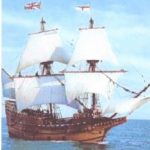 After the Mayflower brought the Plymouth settlers, they struggled under the demands of their English investors for seven years. The investors also sent a letter criticizing the settlers because the Mayflower arrived back in England with an empty hold, and demanding that the Fortune return immediately filled with valuable goods. The colonists complied. For the next six years, they sent sizable shipments, especially of furs, back to England. But the goods yielded far less profit than the investors expected, and as the seven year mark approached, the colonists were still in debt. Finally, 27 of them pooled their personal resources and paid off the debt. Once free of the requirement to live communally and hold all property in common, the original settlers divided the land into private lots, and the era of the “Old Comers” was over.
After the Mayflower brought the Plymouth settlers, they struggled under the demands of their English investors for seven years. The investors also sent a letter criticizing the settlers because the Mayflower arrived back in England with an empty hold, and demanding that the Fortune return immediately filled with valuable goods. The colonists complied. For the next six years, they sent sizable shipments, especially of furs, back to England. But the goods yielded far less profit than the investors expected, and as the seven year mark approached, the colonists were still in debt. Finally, 27 of them pooled their personal resources and paid off the debt. Once free of the requirement to live communally and hold all property in common, the original settlers divided the land into private lots, and the era of the “Old Comers” was over.
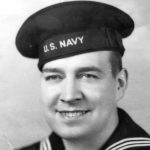 When we think of the name Hitler, most of us think of the vicious dictator who was responsible for the slaughter of as many a 6 million Jewish people, not to mention all the other people he killed in his crazed state of mind. For most of us, hearing the name Hitler brings with it feelings of horror, disgust, and continued shock every time we learn a new fact about Hitler and his Third Reich. Yes, the name Hitler doesn’t usually bring any feelings of…anything good. Well, what I learned today, changed my view of that. You see, not everyone named Hitler was evil, not even everyone named Hitler during World War II, and not even everyone who had the unfortunate…misfortune of being related to Adolf Hitler. You see, for William Patrick Hitler of Liverpool, England, having the name wasn’t the worst part of his situation. William was actually the nephew of Adolf Hitler, the Führer of Nazi Germany. It was a reality that made him almost nauseous. Dealing with that reality would take William on a zigzag path leading to Germany, England, America, and finally the United States Navy. I’m sure that you, like me, thought, “How could the United States Navy allow a nephew of Adolf Hitler to join up, much less to muster out with men sent to fight his uncle.
When we think of the name Hitler, most of us think of the vicious dictator who was responsible for the slaughter of as many a 6 million Jewish people, not to mention all the other people he killed in his crazed state of mind. For most of us, hearing the name Hitler brings with it feelings of horror, disgust, and continued shock every time we learn a new fact about Hitler and his Third Reich. Yes, the name Hitler doesn’t usually bring any feelings of…anything good. Well, what I learned today, changed my view of that. You see, not everyone named Hitler was evil, not even everyone named Hitler during World War II, and not even everyone who had the unfortunate…misfortune of being related to Adolf Hitler. You see, for William Patrick Hitler of Liverpool, England, having the name wasn’t the worst part of his situation. William was actually the nephew of Adolf Hitler, the Führer of Nazi Germany. It was a reality that made him almost nauseous. Dealing with that reality would take William on a zigzag path leading to Germany, England, America, and finally the United States Navy. I’m sure that you, like me, thought, “How could the United States Navy allow a nephew of Adolf Hitler to join up, much less to muster out with men sent to fight his uncle.
Born March 12, 1911, in Liverpool, England, William Hitler was the only child of Bridget Dowling and her Austrian expatriate husband, Alois Hitler Jr, who was the half-brother of Adolf Hitler. In 1914, Alois abandoned his wife and three year old son to go traveling through Europe. The outbreak of World War I prevented him from returning to England, so he settled down in Germany, married again, despite still being married to Dowling, and started a new family. For years, Alois made no attempt to contact his wife and son back in Liverpool, but rather had someone tell Dowling that he was dead. In 1924, the truth came out. Alois was charged with bigamy in Germany, but avoided conviction because Dowling actually interceded on his behalf. That was all she did however. She drew the line, when Alois asked her to send William to Germany for a visit. She told him that she would not let her son visit until he reached his 18th birthday, in 1929. Upon turning 18, William traveled to Germany and reconnected with his father, who took him to a Nazi rally where he saw his Uncle Adolf, leader of the rising National Socialist (Nazi) Party. William visited Germany again in 1930, this time 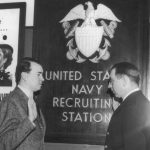 meeting his uncle in person and receiving an autographed photo from him.
meeting his uncle in person and receiving an autographed photo from him.
I’m sure that William thought that his relationship with his uncle would be something that would advance his journalism career, but Hitler didn’t want anyone to know what he was doing. William’s articles about his Uncle Adolf Hitler, only served to be the beginning of being blackballed from everything to do with Adolf Hitler, and his disgust with Adolf Hitler and his insane ways. Hitler called William to Berlin, and reportedly ordered him to retract the articles. Now William saw a totally different side of his uncle…describing it as a “wild-eyed and tearful” outburst. Apparently Hitler even threatened to kill himself if William ever again published anything about his personal life. Now, William became persona non grata in England. He was fired from his job in 1932. Unable to find other employment in his homeland, he decided to look for work in Germany. Perhaps his increasingly influential uncle could be persuaded to help, but no warm welcome awaited in Germany. According to William, whose July 4, 1939 article for Look magazine, “Why I Hate My Uncle,” is the sole source on his dealings with his uncle Adolf Hitler, who sent William a letter during his visit, denying they were relatives. Shortly afterward, William’s father sent him back to England. I guess he was persona non grata with his dad too.
William tried using his relationship to Hitler to obtain a job in Germany, and was successful, but when he tried to send money to his mother, he was informed that Hitler would not allow it…even for family. William began to see a much more evil side of his uncle. Eventually, he left Germany and went back to England, but found that he was not welcome there either. He and his mother moved to the United States, where his relationship again caused him problems. Finally, in 1942, William wrote directly to President Franklin D. Roosevelt, begging to be allowed to serve in the US military. “I am one of many, but can render service to this great cause,” he wrote. FDR passed the letter on to FBI Director J. Edgar Hoover, who looked into William’s background and finally cleared him for military service. Sworn into the US Navy in New York City on March 6, 1944, William Hitler went on to serve three years as a pharmacist’s mate, receiving the Purple Heart for a wound he suffered. He was 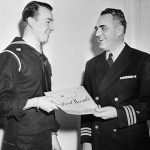 discharged in 1947.
discharged in 1947.
Finally tired of the attention his controversial surname attracted, William changed it to Stuart-Houston after returning to the civilian world. He married German-born Phyllis Jean-Jacques, and the couple settled in Patchogue on New York’s Long Island, where they had four children, the first of whom bore the surprising middle name of Adolf. William ran a blood analysis lab, Brookhaven Laboratories, in his family’s home. William Stuart-Houston died on July 14, 1987, and was buried next to his late mother in Coram, New York. His children did not produce any children of their own…and so ended the line.
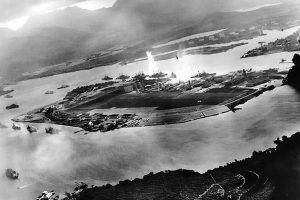
 It doesn’t matter how many years have gone by since that horrible December day 76 years ago today, I don’t think that anyone who knows anything about the attack on Pearl Harbor can forget just how horrific it was. I suppose they should have known that an attack was imminent, or at the very least suspected it. Diplomatic negotiations with Japan had broken down, and President Franklin D. Roosevelt and his advisers knew that an imminent Japanese attack was probable. Still, nothing had been done to increase security at the important naval base at Pearl Harbor. It was critical mistake that would cost a total of 2,400 Americans their lives. In addition, 1,200 were wounded, many while valiantly attempting to defend Pearl Harbor from the attack.
It doesn’t matter how many years have gone by since that horrible December day 76 years ago today, I don’t think that anyone who knows anything about the attack on Pearl Harbor can forget just how horrific it was. I suppose they should have known that an attack was imminent, or at the very least suspected it. Diplomatic negotiations with Japan had broken down, and President Franklin D. Roosevelt and his advisers knew that an imminent Japanese attack was probable. Still, nothing had been done to increase security at the important naval base at Pearl Harbor. It was critical mistake that would cost a total of 2,400 Americans their lives. In addition, 1,200 were wounded, many while valiantly attempting to defend Pearl Harbor from the attack.
It was Sunday morning, and many military personnel had been given passes to attend religious services off base. It should have been a quiet, peaceful, relaxing day. At 7:02am, two radar operators spotted large groups of aircraft in flight toward the island from the north. With a flight of B-17s expected from the United States at the time, they were told to sound no alarm. They were told wrong. At 7:55am Hawaii time, the peaceful day was shattered when, a Japanese dive bomber bearing the red symbol of the Rising Sun of Japan on its wings appeared out of the clouds above the island of Oahu. A swarm of 360 Japanese warplanes followed, descending on the United States naval base at Pearl Harbor. It was a ferocious assault. The surprise attack struck a critical blow against the United States Pacific fleet and drew the United States into World War II…like it or not. The Japanese air assault came as a devastating surprise to the naval base. Much of the Pacific fleet was rendered useless. There was simply no time to act. The window of opportunity for them to act was missed when no warning was given. Five of eight battleships, three destroyers, and seven other ships were sunk or severely damaged, and more than 200 aircraft were destroyed. Japan’s losses were some 30 planes, five midget submarines, and fewer than 100 men, and many of these were intentional suicide bombers. Fortunately for the United States, all three Pacific fleet carriers were out at sea on training maneuvers. These giant aircraft carriers would have their revenge against Japan six months later at the Battle of Midway, in a battle that would reverse the tide against the previously invincible Japanese navy in a spectacular victory.
The day after Pearl Harbor was bombed, President Roosevelt appeared before a joint session of Congress and declared, “Yesterday, December 7, 1941…a date which will live in infamy…the United States of America was suddenly and deliberately attacked by naval and air forces of the Empire of Japan.” After a brief and forceful speech, he asked Congress to approve a resolution recognizing the state of war between the United States and Japan. Finally, the president had taken action. The Senate voted for war against Japan by 82 to 0, and the House of Representatives approved the resolution by a vote of 388 to 1. The sole dissenter was Representative Jeannette Rankin of Montana, a devout pacifist who had also cast a dissenting vote against the United States 
 entrance into World War I. Three days later, Germany and Italy declared war against the United States, and the United States government responded in kind. The American contribution to the successful Allied war effort spanned four long years and cost more than 400,000 American lives. The attack on Pearl Harbor was a vicious attack that shows us that in a war, neutrality is not a guarantee of safety, but is rather viewed as a sign of weakness.
entrance into World War I. Three days later, Germany and Italy declared war against the United States, and the United States government responded in kind. The American contribution to the successful Allied war effort spanned four long years and cost more than 400,000 American lives. The attack on Pearl Harbor was a vicious attack that shows us that in a war, neutrality is not a guarantee of safety, but is rather viewed as a sign of weakness.

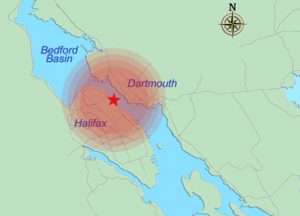 Any time explosives are being transported, there is danger associated with it. Of course, explosives like nitroglycerine used to be very volatile, and just having the bump around on a dirt road could set it off. Things might be safer now, but the danger still exists. On December 6, 1917, in the harbor outside Halifax, Nova Scotia, Canada, a Belgian steamer and French freighter exploded. Both were loaded with ammunition. The explosion was disastrous. Sixteen hundred people were killed immediately. They were sailors looking on from the decks of their ships, rail-workers, and longshoremen. They were onlookers who were drawn to the spectacle of the burning ship. They were laborers looking on from factory windows or doorways, shopkeepers, and firemen. They were wives, mothers and babies, and school children. Just people going about their daily lives, who were caught up in the shocking scene…and it cost them their lives. Nine thousand more people were wounded. The 8 million tons of TNT carried by the ships was intended for use in World War I. The ships were gathered in Halifax, which was the meeting point for convoys to begin the dangerous Atlantic crossing. They would go together as protection from the German U-Boat submarines. The HMS High Flyer was to be the lead ship in the convoy that trip. The freighter from France, the Mont Blanc, had picked up a full load of TNT in New York and came into the harbor that foggy morning. Due to the poor conditions, it collided with the Imo, a Belgian steam boat, also carrying ammunition. A fire resulted and both ships were abandoned immediately.
Any time explosives are being transported, there is danger associated with it. Of course, explosives like nitroglycerine used to be very volatile, and just having the bump around on a dirt road could set it off. Things might be safer now, but the danger still exists. On December 6, 1917, in the harbor outside Halifax, Nova Scotia, Canada, a Belgian steamer and French freighter exploded. Both were loaded with ammunition. The explosion was disastrous. Sixteen hundred people were killed immediately. They were sailors looking on from the decks of their ships, rail-workers, and longshoremen. They were onlookers who were drawn to the spectacle of the burning ship. They were laborers looking on from factory windows or doorways, shopkeepers, and firemen. They were wives, mothers and babies, and school children. Just people going about their daily lives, who were caught up in the shocking scene…and it cost them their lives. Nine thousand more people were wounded. The 8 million tons of TNT carried by the ships was intended for use in World War I. The ships were gathered in Halifax, which was the meeting point for convoys to begin the dangerous Atlantic crossing. They would go together as protection from the German U-Boat submarines. The HMS High Flyer was to be the lead ship in the convoy that trip. The freighter from France, the Mont Blanc, had picked up a full load of TNT in New York and came into the harbor that foggy morning. Due to the poor conditions, it collided with the Imo, a Belgian steam boat, also carrying ammunition. A fire resulted and both ships were abandoned immediately.
The Stella Maris was moving up to the Mont-Blanc at the time of the explosion. The crew were attempting to attach a line to the Mont Blanc to tow it away from Pier 6. When the Mont-Blanc exploded the Stella Maris was swamped and thrown up onto the shore. Captain Brannen and nineteen of his crew members were killed instantly. By some miracle William Nickerson, the second mate, and four of the crew members survived. At Pier 8, to the 
 north of Pier 6, stood the steamer Curaca, that had been loading mules. The Curaca was found in the center of Tuft’s Cove, across the harbor, at Dartmouth, with her bow protruding from the water. The stern of the Curaca was pushed in, her masts and smokestack were blown away. Although the Saint Bernard was on the northern side of Pier 6, the pier offered no protection. The Saint Bernard was completely destroyed along with Pier 6 and the Lola R, a small schooner. Here the Saint Bernard was beached at Parsboro, its home port, during winter prior to the explosion. The Picton was tied up at the Sugar Refinery Wharf just below Pier 6. At the time of the explosion the Picton was being unloaded to undergo repairs. Her cargo included munitions. Due to the quick thinking of the longshoremen the hatches were closed. Although the Picton caught fire, it was quickly put out with the help of the crew of the tugboat Lee. A British ship, the Pictou, was at a pier in the harbor and was also filled with ammunition. The crew of the Pictou immediately fled and set the ship free upon witnessing the collision. The High Flyer was the only ship that took any action to try to stop the disaster…it sent 23 men toward the collision to attempt to sink the vessels. They were too late. Just as they reached the burning ships, a massive explosion occurred.
north of Pier 6, stood the steamer Curaca, that had been loading mules. The Curaca was found in the center of Tuft’s Cove, across the harbor, at Dartmouth, with her bow protruding from the water. The stern of the Curaca was pushed in, her masts and smokestack were blown away. Although the Saint Bernard was on the northern side of Pier 6, the pier offered no protection. The Saint Bernard was completely destroyed along with Pier 6 and the Lola R, a small schooner. Here the Saint Bernard was beached at Parsboro, its home port, during winter prior to the explosion. The Picton was tied up at the Sugar Refinery Wharf just below Pier 6. At the time of the explosion the Picton was being unloaded to undergo repairs. Her cargo included munitions. Due to the quick thinking of the longshoremen the hatches were closed. Although the Picton caught fire, it was quickly put out with the help of the crew of the tugboat Lee. A British ship, the Pictou, was at a pier in the harbor and was also filled with ammunition. The crew of the Pictou immediately fled and set the ship free upon witnessing the collision. The High Flyer was the only ship that took any action to try to stop the disaster…it sent 23 men toward the collision to attempt to sink the vessels. They were too late. Just as they reached the burning ships, a massive explosion occurred.
The explosion sent burning debris throughout Halifax. It also caused a large wave to form that pushed the ships at pier right up out of the harbor. A Canadian army officer stationed at Halifax described the result, “All that could be seen for a great circumference were burning buildings, great mounds of iron and brick in the streets and dead bodies.” A 2½ mile radius was completely demolished and the explosion could be felt 125 miles away. The wave of water hit a Navy ammunition plant located near the shores. That water most likely kept it from catching fire. Most other places nearby were not hit with the wave, unfortunately. The railway station collapsed from the blast and crushed scores of people inside. About 100 more were killed in a sugar plant 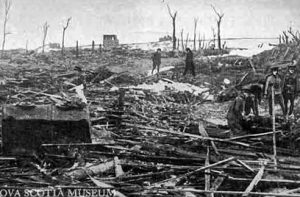
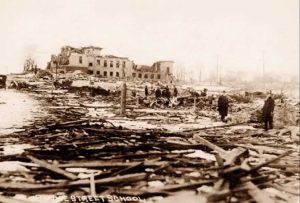 located near the water. Of the 500 students located in schools nearby, less than 10 survived. In all, the death toll was somewhere between 1,200 and 4,000. No one knows for sure because so much of the city was completely obliterated. Many more might have died except for a snowstorm that hit the area later that day. It helped put out the flames, but not before 25,000 people were left homeless in the wake of the disaster.
located near the water. Of the 500 students located in schools nearby, less than 10 survived. In all, the death toll was somewhere between 1,200 and 4,000. No one knows for sure because so much of the city was completely obliterated. Many more might have died except for a snowstorm that hit the area later that day. It helped put out the flames, but not before 25,000 people were left homeless in the wake of the disaster.
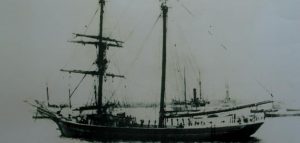 The Mary Celeste began its fateful voyage on November 7, 1872. She set sail with seven crewmen and Captain Benjamin Spooner Briggs, his wife, Sarah, and the couple’s 2-year-old daughter, Sophia. The 282 ton brigantine battled heavy weather for two weeks to reach the Azores. It was there that the ship logged its last entry at 5am on November 25, 1872. The rest of the story of the Mary Celeste remains a mystery, although the ship was found in good shape and completely sea-worthy.
The Mary Celeste began its fateful voyage on November 7, 1872. She set sail with seven crewmen and Captain Benjamin Spooner Briggs, his wife, Sarah, and the couple’s 2-year-old daughter, Sophia. The 282 ton brigantine battled heavy weather for two weeks to reach the Azores. It was there that the ship logged its last entry at 5am on November 25, 1872. The rest of the story of the Mary Celeste remains a mystery, although the ship was found in good shape and completely sea-worthy.
I find it strange to think that in the middle of the ocean, something can happen with little or no warning, that either takes the lives of people onboard a ship, or results in their disappearance. I understand mutiny, but then that does not leave a ship abandoned. So if not mutiny, how is it that the occupants of the ship did not see the other ship approaching? I know that pirates often overtook the ships, but the occupants of the ship were usually killed in a bloody battle. The people onboard did not just disappear. Nevertheless, something happened on the Mary Celeste between that final message on November 25, 1872 and December 5th, 1872, when she was spotted drifting along, in the Atlantic Ocean…empty.
The British brig Dei Gratia was about 400 miles east of the Azores on December 5, 1872, when crew members spotted a ship adrift in the choppy seas. Captain David Morehouse was shocked to discover that the unguided vessel was the Mary Celeste. It had left New York City eight days before him and should have already arrived in Genoa, Italy. He changed course to offer help. Morehouse sent a boarding party to the ship. When they went below decks, they discovered that the ship’s charts had been tossed about, and the crewmen’s belongings were still in their quarters. The ship’s only lifeboat was missing, and one of its two pumps had been disassembled. Three and a half feet of water was sloshing in the ship’s bottom, but the cargo of 1,701 barrels of industrial alcohol was largely intact. There was a six month supply of food and water…and no one to use it. So, the mystery began, and it has endured as one of the most durable mysteries in nautical history…What happened to the ten people who had sailed aboard the Mary Celeste? Over the many years since the discovery, a lack of hard evidence has only created more speculation as to what might have taken place. Theories have ranged from mutiny to pirates to sea monsters to killer waterspouts….some of which are completely ridiculous, but in the absence of evidence, people will speculate.
Arthur Conan Doyle’s 1884 short story based on the case posited a capture by a vengeful ex-slave, a 1935 movie featured Bela Lugosi as a homicidal sailor. Now, a new investigation, drawing on modern maritime technology and newly discovered documents, has pieced together the most likely scenario…which had nothing to do with Bela Lugosi. In fact, while it is unproven, it is thought that something a simple as coal dust could be the culprit. The idea is that the coal dust from a prior voyage filtered into the ships pumps, causing them to quit working. Then, it is thought that the captain, fearing that the ship would sink, ordered the passengers to abandon ship…well within sight of land at Azores. Anne MacGregor, the documentarian who launched the investigation and wrote, directed and produced The True Story of the ‘Mary Celeste,’ partly with funding from Smithsonian Networks. MacGregor learned that on its previous voyage, the Mary Celeste had carried coal and that the ship had recently been extensively refitted. Coal dust and construction debris could have fouled the ship’s pumps, which would explain the disassembled pump found on the Mary Celeste. With the pump inoperative, Briggs would not have known how much seawater was in his ship’s hull, which was too fully packed for him to measure visually. Of course, this is still speculation, because the ten people onboard were never heard from again, so the mystery continues.
to do with Bela Lugosi. In fact, while it is unproven, it is thought that something a simple as coal dust could be the culprit. The idea is that the coal dust from a prior voyage filtered into the ships pumps, causing them to quit working. Then, it is thought that the captain, fearing that the ship would sink, ordered the passengers to abandon ship…well within sight of land at Azores. Anne MacGregor, the documentarian who launched the investigation and wrote, directed and produced The True Story of the ‘Mary Celeste,’ partly with funding from Smithsonian Networks. MacGregor learned that on its previous voyage, the Mary Celeste had carried coal and that the ship had recently been extensively refitted. Coal dust and construction debris could have fouled the ship’s pumps, which would explain the disassembled pump found on the Mary Celeste. With the pump inoperative, Briggs would not have known how much seawater was in his ship’s hull, which was too fully packed for him to measure visually. Of course, this is still speculation, because the ten people onboard were never heard from again, so the mystery continues.
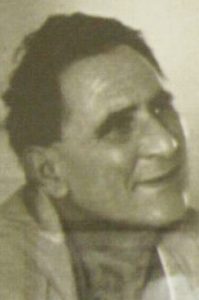 For most of the early years of human history, when a person’s heart gave out…or any other organ, for that matter, it was often the end of that person. Doctors could only do so much, and there are certain body parts that we cannot live without. Of course, these days all that has changed. What used to be considered Frankensteinish, is now a part of modern medicine, and it is saving lives every day. Of course, I don’t think an actual head transplant has ever been done successfully, but many organs are successfully transplanted every day, and every day we hear about some other organ they can transplant…I even read somewhere, and of course, this could be fiction, that they were close to being able to do a brain transplant. I have to admit that the idea of a brain transplant is beyond what I can conceive, but it’s hard to say what is possible…especially when the first heart transplant seemed impossible before December 3, 1967.
For most of the early years of human history, when a person’s heart gave out…or any other organ, for that matter, it was often the end of that person. Doctors could only do so much, and there are certain body parts that we cannot live without. Of course, these days all that has changed. What used to be considered Frankensteinish, is now a part of modern medicine, and it is saving lives every day. Of course, I don’t think an actual head transplant has ever been done successfully, but many organs are successfully transplanted every day, and every day we hear about some other organ they can transplant…I even read somewhere, and of course, this could be fiction, that they were close to being able to do a brain transplant. I have to admit that the idea of a brain transplant is beyond what I can conceive, but it’s hard to say what is possible…especially when the first heart transplant seemed impossible before December 3, 1967.
On that day, 53 year old received the first human heart transplant at Groote Schuur Hospital in Cape Town, South Africa. Washkansky was a South African grocer dying from chronic heart disease. Then, Denise Darvall, a 25 year old woman was fatally injured in a car accident. Surgeon Christiaan Barnard, who had trained at the University of Cape Town and in the United States, performed the revolutionary medical operation. The technique Barnard employed had been initially developed 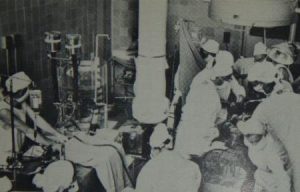 by a group of American researchers in the 1950s. American surgeon Norman Shumway achieved the first successful heart transplant, in a dog, at Stanford University in California in 1958, but prior to that time, transplants were simply a theory.
by a group of American researchers in the 1950s. American surgeon Norman Shumway achieved the first successful heart transplant, in a dog, at Stanford University in California in 1958, but prior to that time, transplants were simply a theory.
A successful heart transplant, or any transplant for that matter, does not necessarily mean a long life after the transplant…unfortunately. After Washkansky’s surgery, he was given drugs to suppress his immune system and keep his body from rejecting the heart. Those drugs worked well, in that Washkansky’s new heart had functioned normally until his death. Nevertheless, these drugs also left him susceptible to sickness, and 18 days later he died from double pneumonia. While losing him was a devastating setback, in the realm of transplants, the operation was an amazing success. Still, a successful transplant was not going to help people to survive, if the anti-rejection medications stifle the immune system and cause the patient to get sick and die 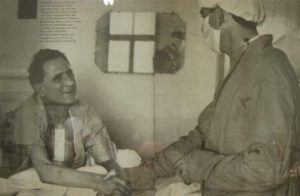 of other illnesses that would have been harmless otherwise.
of other illnesses that would have been harmless otherwise.
In the 1970s, the development of better anti-rejection drugs gave new hope to the transplantation program. Dr. Barnard continued to perform heart transplant operations, and by the late 1970s many of his patients were living up to five years with their new hearts. Successful heart transplant surgery continues to be performed today, but finding appropriate donors is extremely difficult, because the donor must be a match to the patient in blood type and other factors. All too often, the patient waiting for a transplant, dies before a viable donor can found.

